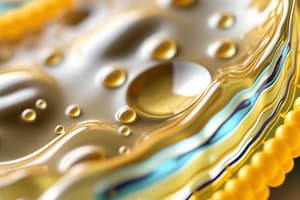Podcast
Questions and Answers
Which of the following are modes of mobility in a lipid bilayer? (Select all that apply)
Which of the following are modes of mobility in a lipid bilayer? (Select all that apply)
- Axial rotation (correct)
- Flip-flop (correct)
- Fast lateral diffusion (correct)
- Vertical diffusion
- Intra-chain motion (correct)
What percentage of total membrane lipid does cholesterol make up?
What percentage of total membrane lipid does cholesterol make up?
45%
Cholesterol reduces phospholipid packing and increases membrane fluidity.
Cholesterol reduces phospholipid packing and increases membrane fluidity.
True (A)
What are the two structures that amphipathic molecules can form in water?
What are the two structures that amphipathic molecules can form in water?
What is the typical protein content in biological membranes?
What is the typical protein content in biological membranes?
Lipid bilayers allow high permeability to ions and most polar molecules.
Lipid bilayers allow high permeability to ions and most polar molecules.
What effect do unsaturated double bonds in fatty acids have on membrane fluidity?
What effect do unsaturated double bonds in fatty acids have on membrane fluidity?
What is the major class of membrane lipids?
What is the major class of membrane lipids?
Plasmalogens are a subclass of phospholipids found in ______ systems.
Plasmalogens are a subclass of phospholipids found in ______ systems.
Which of the following statements about glycolipids is true?
Which of the following statements about glycolipids is true?
What major structural component distinguishes sphingomyelin from other phospholipids?
What major structural component distinguishes sphingomyelin from other phospholipids?
What is a primary function of membrane proteins?
What is a primary function of membrane proteins?
Flashcards are hidden until you start studying
Study Notes
Dynamics in Lipid Bilayers
- Membranes are fluid, with lipid molecules exhibiting four primary mobility modes: fast lateral diffusion, flip-flop movement, intra-chain motion, and fast axial rotation.
- Flip-flop involves lipid molecules exchanging positions from one half of the bilayer to the other.
Cholesterol
- Comprises 45% of total membrane lipids and contributes to plasma membrane structure.
- Distribution varies by tissue type and correlates with specific functions.
- Stabilizes the membrane through hydrogen bonding with fatty acid chains, reducing the endothermic phase transition of phospholipid bilayers.
- Cholesterol decreases phospholipid packing and increases overall membrane fluidity but simultaneously restricts chain motion.
Lipid Bilayer Formation
- Formed by amphipathic molecules in water, leading to spontaneous bilayer formation due to van der Waals forces among hydrophobic tails.
- Maintained by non-covalent forces, including electrostatic and hydrogen bonds, between hydrophilic parts and water.
- Serves as a preferred structure for phospholipids and glycolipids, displaying low permeability to ions and many polar molecules.
Unsaturated Fatty Acids and Cholesterol
- Unsaturated bonds disrupt orderly packing of phospholipids, enhancing membrane fluidity.
Membrane Proteins
- Perform various functions: enzymes, transporters, pumps, ion channels, receptors, energy transducers.
- Protein proportion varies, from about 18% in myelin to 75% in mitochondria, with membranes typically containing 60% protein by dry weight.
Mobility of Membrane Proteins
- Proteins in bilayers exhibit three motion modes: conformational change, rotational motion, and lateral movement, but do not flip-flop due to their large hydrophilic portions.
Restrictions on Protein Mobility
- Influenced by lipid-mediated effects, associations with other membrane proteins, and interactions with peripheral proteins such as the cytoskeleton.
General Functions of Biological Membranes
- Serve as selective permeability barriers, controlling the internal chemical environment.
- Enable communication and signal generation in response to various stimuli.
- Facilitate recognition through signaling molecules and adhesion proteins.
Membrane Composition
- Composed of approximately 40% lipid, 60% protein, 1-10% carbohydrate, and 20% water, indicating hydration in the membrane structure.
Membrane Lipids
- Comprise phospholipids, glycolipids, and cholesterol, characterized as amphipathic.
Phospholipids
- The dominant lipid type, such as phosphatidylcholine, featuring diverse polar head groups (e.g., choline, amines, sugars).
- Fatty acid chains are variable, with C16 and C18 being prevalent; unsaturated fatty acids impart a kink that reduces packing efficiency.
Non-Classical Phospholipids
- Plasmalogens, found in the nervous, immune, and cardiovascular systems, represent a subclass of phospholipids.
- Sphingomyelin, a sphingolipid found in the myelin sheath surrounding nerve cell axons, is unique as it is not based on glycerol.
Glycolipids
- Composed of carbohydrate-containing structures with hydrophobic fatty acid tails.
- Types include cerebrosides (sugar monomer head groups) and gangliosides (sugar oligomer head groups).
Studying That Suits You
Use AI to generate personalized quizzes and flashcards to suit your learning preferences.



